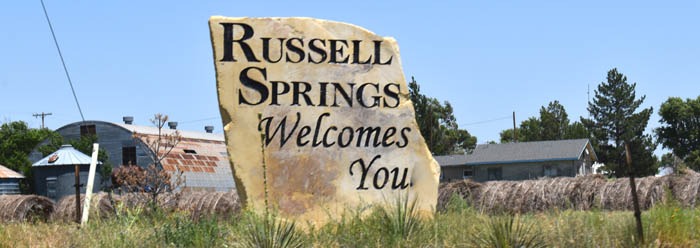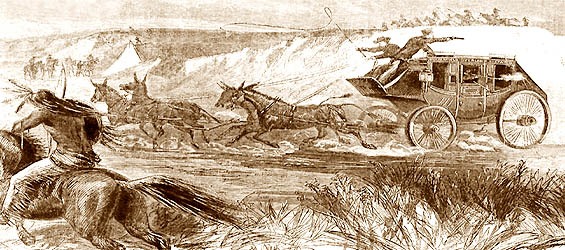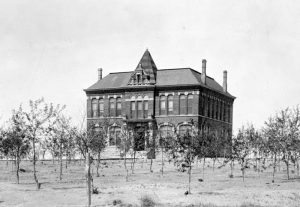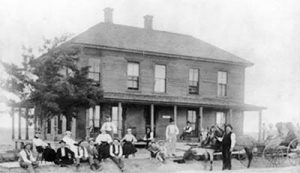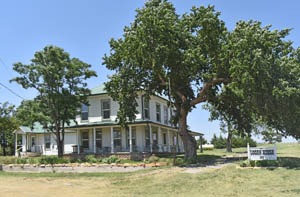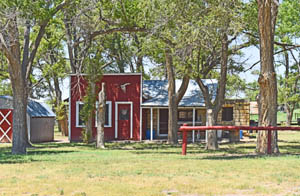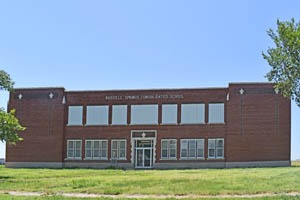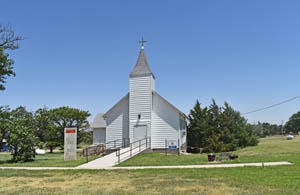Though Russell Springs, Kansas, is a semi-ghost town today, it served as the Logan County seat for 76 years before losing the seat to Oakley. Located on the Smoky Hill River, Russell Springs is situated on a beautiful site on the ridge that forms the north side of the valley of the Smoky Hill River.
The town began in 1865 as the Eaton stop on the Butterfield Overland Despatch stage line. The line ran through rough Indian country along the Smoky Hill Trail that connected Fort Riley, Kansas, with the gold mines in Denver, Colorado.
Travelers on the Smoky Hill Trail made the natural springs in the area a watering place and called them “Russell’s Springs.” It was named for the earliest known settler of the area — William D. Russell, a cattleman who ran large cattle on the open range. The cattle were watered at the clear-water springs near where the town would eventually be located.
Russell Springs gained a post office on March 3, 1887, and the town was laid out in April by the Pioneer Town Company. Situated in the center of the county Russell Springs was the perfect location for the county seat, and the town company invested in making it so.
The Pioneer Town Company spent a great deal of money on improvements, including a waterworks system, an artificial lake stocked with fish and fowl, a $25,000 courthouse, and a $10,000 schoolhouse. On September 7, 1887, Governor John A. Martin named Russell Springs the temporary county seat and appointed officers. That fall, over 100 houses were built, a hotel, two churches, a bank, and several stores.
However, Russell Springs was not the only town that wanted to become the county seat. Oakley, situated in the county’s northeast corner and the most populous town in the county, was making every effort to gain an advantage. It was incorporated as a third-class city and advertised wildly, promoting its rich and bountiful soil and its branch line of the Union Pacific Railroad from Oakley to Colby.
Ennis City (present-day Monument) advertised its location near the center of the county and had dreams of becoming the largest city in western Kansas. John B. Ennis, the promoter, stressed opportunities for all classes of people in the heart of this rich agricultural land. His brochure stated, “The boom is on; there is no better place for investments and rare opportunities for the early comers.”
On November 21, 1887, the Russell Springs town company presented a deed of its townsite to Logan County commissioners with the promise that they would convey the land to the county if Russell Springs became the permanent county seat of Logan County.
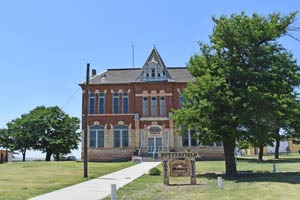
The old Logan County Courthouse in Russell Springs, Kansas, now serves as the Butterfield Trail Museum by Kathy Alexander.
In the election in December 1887 for the permanent county seat, almost all the towns in the county were on the ticket, including Russell Springs, Logansport, McAllaster, Elkader, Oakley, Monument, and VIinona. Russell Springs won by 276 votes, and officers were elected. The new county started with indebtedness of less than $3,000.
On Christmas Eve, a celebration dance was held in the new courthouse. Officers moved into the new Logan County courthouse in January 1888. In April of that year, Russell Springs was incorporated as a city of the third class. At that time, the town’s population was said to be almost 800. However, that number appears to be exaggerated as later sources list the number of residents much lower in the next few years.
In the summer of 1888, a nickel vein was discovered a few miles southwest of Russell Springs. Stirring up much excitement, more than 60 mining claims had been taken in the rocky portions of the county in just a few weeks. At that time, the town had a few hundred people and boated two weekly newspapers, two hotels, a bank, several stores, a livery stable, the Union Church, two physicians, and several lawyers. However, it did not have a railroad, and the nearest line was the Kansas Pacific Railroad tracks about 12 miles north.
With prospectors flooding in, some by outsiders from as far away as Denver, Colorado, a hack line began to offer regular services between the mine site and Russell Springs at 75¢ round trip. The nickel fever soon spilled over into other parts of the county as any dark-looking rock was considered possible nickel ore by prospectors and investors.
However, it was soon found that mining would not be profitable because of the low percentage of nickel in the ore, without a smelter in the area, and the distance to the railroad. Within months, the mining rush was over. Afterward, some said the whole thing was a hoax by the Western Nickel and Cobalt Mining Company, whose members may have “salted” with real nickel ore so that the company could sell stock and establish a mining district.
In 1890, the population of Russell Springs was 117, and in the next two decades, it would continue to drop.
In 1910, it had a population of just 82, but it still had a bank, a weekly newspaper called the Leader, a school, churches, and several retail businesses. Then came the news that a railroad was to be built through the town, and the residents had high hopes.
In 1911, the Colorado, Kansas, and Oklahoma Railroad was routed from Scott City, Kansas, to Winona via Russell Springs. Unfortunately, the railroad had financial difficulties, and in 1917 it ceased operation. The tracks were later removed and used for World War I efforts.
However, the town grew in the following years until its population peaked at 198 in 1940.
Though Russell Springs remained very small, efforts to move the county seat to the larger town of Oakley were defeated in 1937, 1945, and 1960. However, in 1963, Russell Springs lost the election, and the county offices were moved to Oakley, which had prospered through the years due largely to the Union Pacific Railroad.
In 1965, the old county courthouse in Russell Springs became the Butterfield Trail Museum. The building was listed on the National Register of Historic Places in 1972.
At some point, the Russell Springs schools were closed through school consolidation, and today students attend the USD 275 Triplains school in Winona.
The Russell Springs post office closed on November 7, 1997. Its population is just about 24 today.
© Kathy Alexander/Legends of America, updated July 2022.
Also See:
A Journey to Denver via the Butterfield Overland Despatch
Sources:
Blackmar, Frank W.; Kansas: A Cyclopedia of State History, Vol I; Standard Publishing Company, Chicago, IL 1912.
Butterfield Trail Museum
Kansas State Historical Society
Fort Hays State University
http://genealogytrails.com/kan/logan/history.html
Wikipedia

